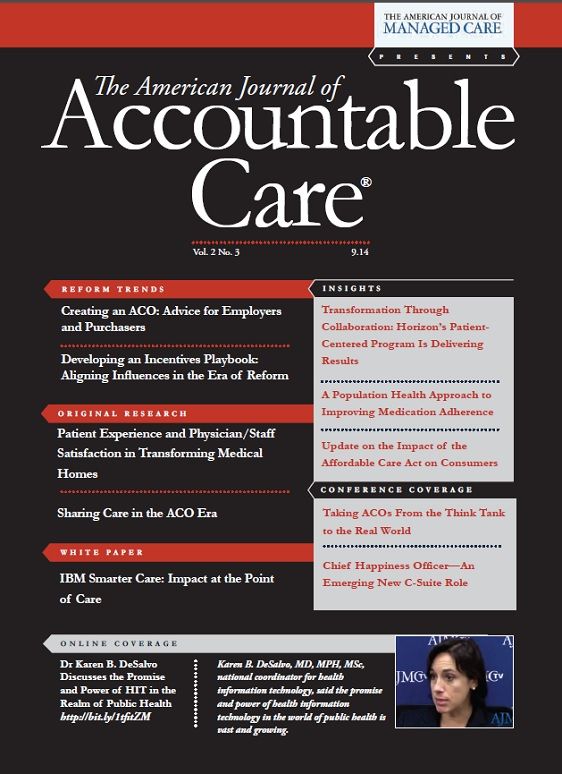- Center on Health Equity & Access
- Clinical
- Health Care Cost
- Health Care Delivery
- Insurance
- Policy
- Technology
- Value-Based Care
Alignment of Consumer and Provider Incentives: As Easy as Peanut Butter and Jelly
The United States is in the throes of multiple experiments aimed to shift care delivery from a volume-based to a value-based system. This issue of AJAC examines a number of cutting-edge strategies.
The United States is in the throes of multiple experiments aimed to shift care delivery from a volume-based to a value-based system. The American Journal of Accountable Care (AJAC) strives to be a trusted source for balanced information regarding the development, implementation, and evaluation of emerging solutions to increase efficiency. This issue of AJAC examines a number of cutting-edge strategies including accountable care organizations (ACOs),1 patient-centered medical homes (PCMHs),2 and innovative payment models such as bundled payments,3 which are intended to improve quality, enhance the consumer experience, and constrain cost growth.
As these manuscripts attest, a substantial amount of energy, sophistication, and resources are being applied to “supply side” initiatives aimed at changing clinician practice, such as payment reform, health information technology, and practice redesign. For the sake of discussion, I refer to provider-facing initiatives as “peanut butter.” Unfortunately, these “supply-side” initiatives have historically paid little attention to consumer decision making or the “demand side” of care-seeking behavior. I designate these consumer-facing strategies, such as literacy programs, shared decision making, price transparency, and benefit designs, as “the jelly.” Consumer engagement initiatives that motivate individuals to access care based on quality and cost information—including incentives tied to clinical necessity—can enhance the quality of care and reduce healthcare spending.
As we embrace models that provide incentives to clinicians to recommend the right care, to the right patient, in the right venue, at the right price, it is of critical importance that consumer incentives be similarly aligned. For a physician practicing in a quality-driven reimbursement program, it is incomprehensible that insurance plans increasingly place barriers which restrict patient access to those exact high-quality services for which the clinician, the PCMH, and the ACO are benchmarked. It makes no sense to offer clinicians a financial bonus to get their diabetic patients’ blood sugar under control or eyes examined, when those same patients are increasingly enrolling in a benefit design that makes it prohibitively expensive to fill their prescription or visit the ophthalmologist. While the obvious synergies of combining peanut butter and jelly are exemplary of “the sum greater than the parts,” high cost-sharing for services established as quality metrics (eg, National Quality Forum, National Committee for Quality Assurance) is a classic illustration of misaligned incentives.
When healthcare purchasers align provider and consumer incentives around value—not price alone—the goals of the Triple Aim are more likely to be achieved than with either one alone. This alignment will facilitate a shift toward a delivery system that rewards both patients and providers for delivery of high-value care.1. Higgins TL, Hodnicki D, Artenstein AW. Sharing care in the ACO era. AJAC. 2014 2(3):27-30.
2.. Solberg L, Stuck L, Crain LA, et al. Patient experience and physician/staff satisfaction in transforming medical homes. AJAC. 2014 2(3):11-15.
3. Delbanco S, Lansky D. Creating an ACO: advice for employers and purchasers. AJAC. 2014; 2(3):46-57.

Blister Packs May Help Solve Medication Adherence Challenges and Lower Health Care Costs
June 10th 2025Julia Lucaci, PharmD, MS, of Becton, Dickinson and Company, discusses the benefits of blister packaging for chronic medications, advocating for payer incentives to boost medication adherence and improve health outcomes.
Listen
Linking Data to Determine Risk for 30-Day Readmissions in Dementia
December 22nd 2025This study found that certain characteristics in linked electronic health record data across episodes of care can help identify patients with Alzheimer disease and related dementias at high risk of 30-day readmissions.
Read More

